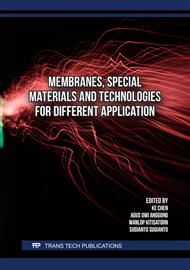p.3
p.11
p.17
p.27
p.35
p.49
p.55
p.61
Effect of Starch-Based Adhesives in the Production of Plaster Casts from Industrial Waste
Abstract:
In this work, the waste gypsum from industry is repurposed to add value in the medical field by transforming it into Plaster cast. The waste gypsum or calcium sulfate dihydrate is heated to a temperature of 120 °C for three hours to obtain calcium sulfate hemihydrate or Plaster of Paris. Subsequently, it is mixed with water in a 1:1 ratio before embedded on gauze. To enhance the strength of the plaster cast, different types of starch-based adhesives are mixed with plaster solution to investigate their impact on shaping and the strength of the plaster. Three types of starch, including potato starch, tapioca starch, and cornstarch, are utilized. After testing the strength of plaster cast mixed with adhesive starch, it is found that with 5% potato starch, the plaster cast exhibits the highest strength among all variants. In addition, its result from SEM indicated that the potato starch was distributed and packed tightly onto gauze.
Info:
Periodical:
Pages:
11-16
Citation:
Online since:
December 2024
Authors:
Keywords:
Price:
Сopyright:
© 2024 Trans Tech Publications Ltd. All Rights Reserved
Share:
Citation:



